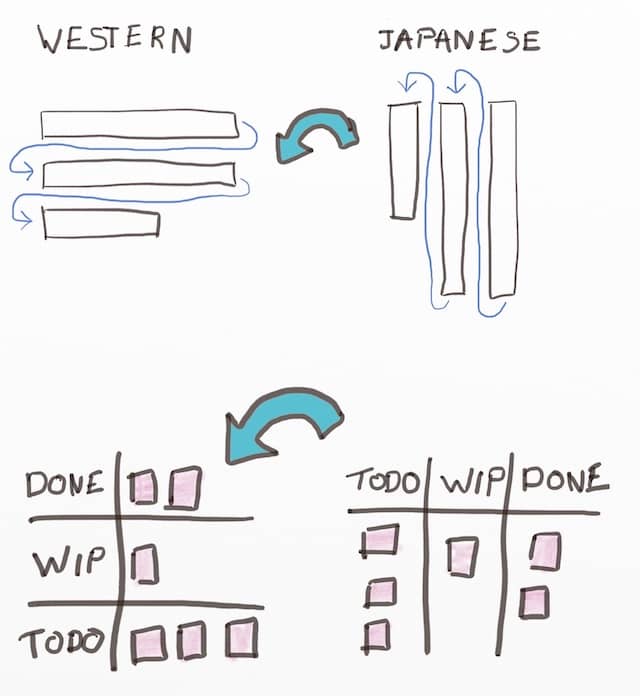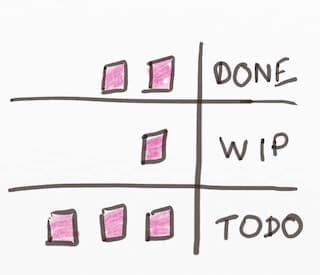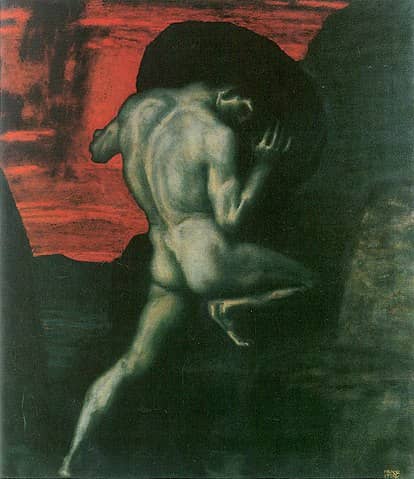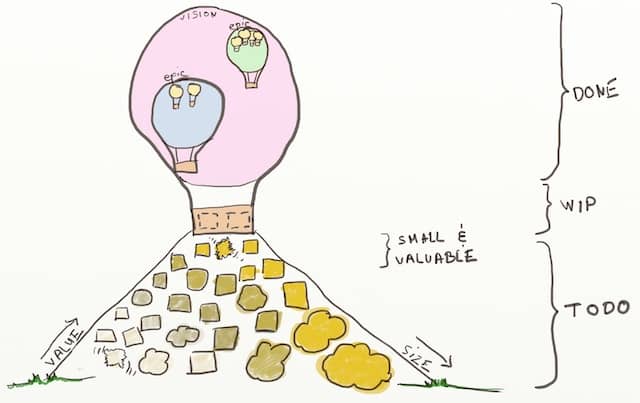Vertical Kanban Board Setups
Turning Kanban boards vertically fits western cultures better. Improving UX of our process tools would eventually lead to a more effective and sustainable pace.
My previous post detailed how flipping Kanban boards columns makes Kanban more effective. I suggested that Kanban works in Japan because of the Japanese language’s orientation.
Culturally oriented Kanban
Kanban and Kanban boards came from Japan. Traditionally, Japanese reads in columns, from right to left. Kanban boards use columns too, but flow from left to right! Japanese people ‘pull’ items from left-TODO to right-DOING. It makes sense to them because they are pulling against the traditional word flow.
When I was at NewCraft this year, Nat Pryce gave a presentation about the metaphors we use in software. He mentioned widespread metaphors we rely on, that we are not even aware of.
Many metaphors are culture dependent. Let’s see what the Kanban board setup would look like if we adapted it to the Western text orientation.

Benefits
The first benefit is when we display this board on the wall. DONE and DOING areas would be at eyes height. We would need an extra effort to look at items that are still TODO. This would reduce Work In Progress, multitasking and stress. In the end, it would contribute to a more sustainable pace.
Another benefit is when we display such a board on a computer screen. TODO items would be at the bottom of the board. They are likely not to appear on the screen when we open the board. Again, we would need the extra scrolling to see what’s TODO. And again, this would result in a more sustainable pace.
Finally, it makes more sense vocabulary-wise. Kanban is a pull system. Did you ever try to pull something from the left with one arm? Pulling from a side does not work well. As my Aikido master would say, it’s a great way to hurt yourself. When we want to pull something heavy, we usually start by facing it. Most of the time, we’ll pull from in ahead, or from below.
Regional settings
💡 We need to adapt Kanban boards according to people’s cultures.
All this is culture dependent. As I said, I’m French, and this Kanban board setup works well for Western cultures. We need to adapt Kanban boards according to people’s cultures. People who read lines from right to left, might prefer this orientation:

Fortunately for digital boards, our computers have regional settings. The software could adapt Kanban boards orientations to the client’s regional settings!
For obvious reasons, orienting the physical board according to local culture should suit most people using it.
Humane tools
💡 Could we make these sad, sterile and mechanic process tools more humane?
Let’s dream for a while and push things even further. What we are talking about is actually UX for Kanban boards. Could we make these sad, sterile and mechanic tools more humane? Up to now, all we did has been to copy-paste physical boards on a screen. Could we use technology to build something better? Here is what such a Kanban could look like:
We could add animations, visual hints, interaction, gamification… All this to help us perform our work at a sustainable pace.
TODO cesspool
The TODO area is usually a mess made of in-the-shower ideas, half specified stories, fully detailed tasks, large or small epics, valuable or not stories… We could use visual clues to make all this jump to our faces:
- bigger cards for larger items
- shiny cards for high value items
- jiggling cards for risky items
- blurry cards for unclear items
- we could orient all this mess over 2 axes, value and size for example, to spot items that are ready to start
DOING overload
The DOING section is often overloaded with too much work.
- We could make the DOING bottleneck visible with a funnel shape
- We could have small task slots to make sure we cannot start items that are too big
DONE Sisyphus tasks

Software too often feels like Sisyphus task. As soon as something is finished, a new task takes its place to keep us busy… until we retire.
- We could have mini-rewards when things get done (quotes, songs, tweets, notifications, gifts, sustainable pace advices …)
- We could use a metaphor, like air balloons, for Stories, Epics and products. When enough story balloons are done, they’ll lift their epic balloon…
- Quantified OKRs would also make a great progress tracking system here. (I’ll blog about that some day)
Back to reality
Enough dreaming… I don’t know of such tool yet. If you know something like this, I’d be happy to learn about it. Otherwise, this would make a great open-source side-project. What do you think? Would you use it? Would you contribute?
Thanks to Damien, Matthieu and Xavier for reviewing this post






Leave a comment